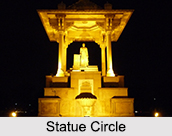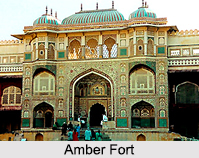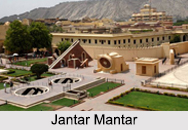 Monuments of Jaipur, Rajasthan are important tourist attractions in western India. Jaipur is a reservoir of the architectural wonders embracing the rich inheritance of India. The monuments in Jaipur depict the glory of the bygone era and boast of the royalty of Jaipur.
Monuments of Jaipur, Rajasthan are important tourist attractions in western India. Jaipur is a reservoir of the architectural wonders embracing the rich inheritance of India. The monuments in Jaipur depict the glory of the bygone era and boast of the royalty of Jaipur.
Monuments in Jaipur
There are many forts and monuments in Jaipur that are worth seeing. Amber Fort, Jaigarh Fort and Nahargarh Fort are the three historic forts that provide the impressive view of the city. In the heart of Jaipur, there lies the spectacular City Palace. Jaipur, the Pink city, marks its influence with the sight of the amazing Hawa Mahal. Statue Circle is also one of the main attractions of Jaipur, which commemorates the creator of this city. Along with these, there are several other monuments and those are:
Gaitore: It is a memorial of the Royal kings and is eminent for its delightfully carved cenotaphs. Gaitore is a royal cremation site of the regal rulers of Jaipur, which is situated on the Jaipur-Amber road, about 15 km from Jaipur. There is a commemorative plaque for each Maharaja, built in his honor. These royal cenotaphs of the Maharajas are popularly known as `Chhatris`.
Jantar Mantar: The enormous Jantar Mantar of Jaipur anticipates the story of Raja Sawai Jai Singh, who was known as the noble king of Jaipur. Jantar Mantar is considered to be one of the largest observatories of the world. Combining religion with science and art, Jantar Mantar is the name given to a series of five magnificent structures built in Jaipur, New Delhi, Ujjan, Varanasi and Mathura.
 Amber Fort: Amber Fort was used as the capital of the Kachhwaha clan, till Jaipur was declared as the official capital in 1727. The Amber Fort looks startling, which is built in white marble and red sandstone. To add to its charm, Maotha Lake is in its foreground. This fort was built in 1592 by Raja Man Singh. It is also known as Amer palace.
Amber Fort: Amber Fort was used as the capital of the Kachhwaha clan, till Jaipur was declared as the official capital in 1727. The Amber Fort looks startling, which is built in white marble and red sandstone. To add to its charm, Maotha Lake is in its foreground. This fort was built in 1592 by Raja Man Singh. It is also known as Amer palace.
City Palace: City Palace forms one of the most famous tourist attractions and a major milestone in the history of Jaipur. Maharaja Sawai Jai Singh built this beautiful palace during his reign. Among the various palaces and monuments of Jaipur, City Palace stands apart, owing to its outstanding art and architecture. City Palace complex encompasses a huge area, which is divided into an array of gardens, courtyards and buildings. Initially, Raja Jai Singh built the outer wall occupying a huge area, later the additional grand buildings were constructed by the succeeding rulers.
Hawa Mahal: It is a major landmark of Jaipur, which is a beautiful sight to behold. This famous tourist attraction site portrays Rajputana architecture and speaks the glory of the royal family. This grand five storey palace was constructed in 1799 by Maharaja Sawai Pratap Singh who belonged to Kachhwaha Rajput dynasty.
Jaigarh Fort: Jaigarh Fort is located on the top of a hill; it is also known as Cheel ka Teela (Hill of Eagles). This fort was built by Sawan Jai Singh II. Jaigarh Fort is surrounded by huge battlements and it is connected to the Amber Fort with subterranean passages.
Nahargarh Fort: Built-in 1734 by Maharaja Sawai Jai Singh II and extended over the years; Nahargarh Fort in Jaipur is of great historical significance. This fort featured in the treaties, which were drawn up between the Rajput and Maratha forces in the 18th century as a means of preventing war and conflict. Nahargarh Fort provides an astounding view of Jaipur city which is one of the reasons it was a retreat residence when in use.
Statue Circle: Statue Circle forms a major landmark of Jaipur, with the statue of King Sawai Jai Singh, the founder of Jaipur.
 Albert Hall: Albert Hall is both a museum and a monument of historical importance in Jaipur. It was built by King Edward II and opened to the public in 1887. From the outside it is an impressive structure with history that is kept in the museum inside the building.
Albert Hall: Albert Hall is both a museum and a monument of historical importance in Jaipur. It was built by King Edward II and opened to the public in 1887. From the outside it is an impressive structure with history that is kept in the museum inside the building.
Sisodia Rani Garden and Palace: Sisodia Rani Garden and palace were built in 1728 by Maharaja Sawai Jai Singh II. These are testaments to the aesthetics of Jaipur in the times of Rajput royalty.
The monuments in Jaipur are some of the unmatched artistic creations of India. People from all over the world come to visit these memoirs of the former age. Government of Rajasthan is implementing certain measures on these monuments to safeguard these priceless monuments of the previous period. These epoch-making monuments in Jaipur are worth visiting.



















